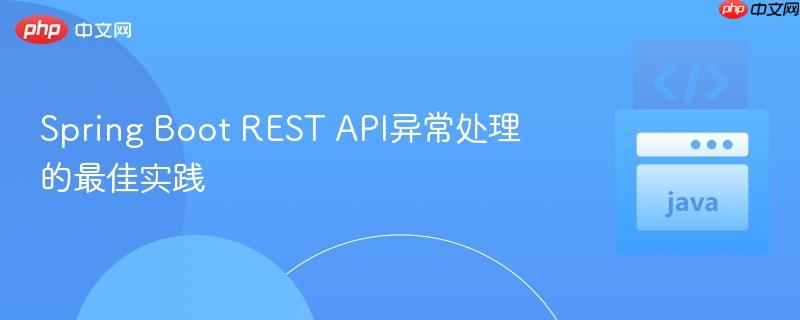
本文旨在探讨spring boot rest api中异常处理的最佳实践,强调应避免使用泛型`exception`,而是通过定义特定的业务异常来提升代码可读性和维护性。我们将详细介绍如何在控制器内部使用`@exceptionhandler`进行局部异常处理,以及如何利用`@controlleradvice`实现全局、集中的异常管理,从而构建健壮且响应友好的api服务。
在Spring Boot构建RESTful API时,有效的异常处理机制是确保服务稳定性和用户体验的关键。不恰当的异常处理,例如在业务逻辑中随意抛出泛型Exception,不仅会模糊错误类型,还会使客户端难以理解和响应。本教程将指导您如何采用更专业、更可维护的方式来处理API中的异常。
在业务逻辑层(Service层)直接抛出new Exception("...")是一种不推荐的做法。泛型Exception缺乏语义,无法清晰地表达具体发生了何种业务错误。这使得调用方(包括控制器和客户端)难以针对特定错误进行处理。
不推荐的做法示例:
public Optional<Item> getSpecificItem(Long itemId) throws Exception {
// 这种方式抛出泛型Exception,不易于后续处理
return Optional.ofNullable(itemRepository.findById(itemId)
.orElseThrow(() -> new Exception("Item with that id doesn't exist")));
}问题分析: 这种做法强制调用方捕获一个宽泛的Exception,而不是一个具体的业务异常,导致代码耦合度高,且难以根据错误类型采取不同的恢复策略。
最佳实践是为特定的业务场景定义自定义异常类。这些异常类通常继承自RuntimeException(使其成为非检查异常),这样可以避免在方法签名中声明大量的throws子句,同时保持代码的整洁。
示例:定义一个自定义异常
// ItemNotExistException.java
public class ItemNotExistException extends RuntimeException {
public ItemNotExistException(String message) {
super(message);
}
}在Service层抛出自定义异常:
// ItemService.java
import org.springframework.stereotype.Service;
import java.util.Optional;
@Service
public class ItemService {
private final ItemRepository itemRepository; // 假设有一个ItemRepository
public ItemService(ItemRepository itemRepository) {
this.itemRepository = itemRepository;
}
public Optional<Item> getSpecificItem(Long itemId) {
// 抛出自定义的ItemNotExistException
return Optional.ofNullable(itemRepository.findById(itemId)
.orElseThrow(() -> new ItemNotExistException("Item with ID " + itemId + " does not exist")));
}
}现在,ItemNotExistException清晰地表达了“商品不存在”这一业务含义。
对于某些只在特定控制器或少数方法中出现的异常,可以在控制器内部使用@ExceptionHandler注解进行局部处理。这种方式的优点是异常处理逻辑紧邻业务逻辑,但缺点是如果多个控制器需要处理同一种异常,则会造成代码重复。
示例:控制器内部处理ItemNotExistException
// ItemController.java
import org.springframework.http.HttpStatus;
import org.springframework.web.bind.annotation.*;
@RestController
@RequestMapping("/items")
public class ItemController {
private final ItemService itemService;
public ItemController(ItemService itemService) {
this.itemService = itemService;
}
@GetMapping("/{itemId}")
public Item getItem(@PathVariable Long itemId) {
return itemService.getSpecificItem(itemId)
.orElseThrow(() -> new ItemNotExistException("Item with ID " + itemId + " not found via service."));
}
// 控制器内部的异常处理器
@ExceptionHandler(ItemNotExistException.class)
@ResponseStatus(HttpStatus.NOT_FOUND) // 设置HTTP响应状态码为404
public String handleItemNotExistException(ItemNotExistException ex) {
return ex.getMessage(); // 返回异常消息作为响应体
}
}在上述示例中,当getItem方法抛出ItemNotExistException时,handleItemNotExistException方法会被激活,并返回异常消息,同时设置HTTP状态码为404 Not Found。
对于需要在整个应用程序范围内统一处理的异常(例如所有控制器都可能抛出的通用业务异常或系统异常),@ControllerAdvice提供了一个集中化的解决方案。它允许您定义一个全局的异常处理器,拦截所有控制器抛出的特定类型异常。
示例:全局异常处理ItemNotExistException
首先,确保您的Service层和Controller层抛出的是自定义异常,如前文所示。
// GlobalExceptionHandler.java
import org.springframework.http.HttpStatus;
import org.springframework.web.bind.annotation.ControllerAdvice;
import org.springframework.web.bind.annotation.ExceptionHandler;
import org.springframework.web.bind.annotation.ResponseBody;
import org.springframework.web.bind.annotation.ResponseStatus;
@ControllerAdvice
@ResponseBody // 如果需要返回JSON/XML等响应体
public class GlobalExceptionHandler {
@ExceptionHandler(ItemNotExistException.class)
@ResponseStatus(HttpStatus.NOT_FOUND) // 设置HTTP状态码为404
public ErrorResponse handleItemNotExistException(ItemNotExistException ex) {
// 可以返回一个自定义的错误响应对象,包含更多信息
return new ErrorResponse(HttpStatus.NOT_FOUND.value(), ex.getMessage());
}
// 示例:处理其他自定义异常,如SkyIsRedException
@ExceptionHandler(SkyIsRedException.class)
@ResponseStatus(HttpStatus.BAD_REQUEST)
public ErrorResponse handleSkyIsRedException(SkyIsRedException ex) {
return new ErrorResponse(HttpStatus.BAD_REQUEST.value(), ex.getMessage());
}
// 您还可以定义一个通用的异常处理器来捕获所有未被特定处理器捕获的异常
@ExceptionHandler(Exception.class)
@ResponseStatus(HttpStatus.INTERNAL_SERVER_ERROR)
public ErrorResponse handleGenericException(Exception ex) {
// 记录日志
// ex.printStackTrace();
return new ErrorResponse(HttpStatus.INTERNAL_SERVER_ERROR.value(), "An unexpected error occurred.");
}
}自定义错误响应对象(可选):
为了提供更友好的错误信息,您可以定义一个统一的错误响应结构:
// ErrorResponse.java
public class ErrorResponse {
private int status;
private String message;
private long timestamp;
public ErrorResponse(int status, String message) {
this.status = status;
this.message = message;
this.timestamp = System.currentTimeMillis();
}
// Getters for status, message, timestamp
public int getStatus() { return status; }
public String getMessage() { return message; }
public long getTimestamp() { return timestamp; }
}@ControllerAdvice的优势:
通过遵循这些最佳实践,您可以构建出更加健壮、可维护且用户友好的Spring Boot REST API。正确的异常处理不仅能提升代码质量,还能显著改善API的可靠性和可用性。
以上就是Spring Boot REST API异常处理的最佳实践的详细内容,更多请关注php中文网其它相关文章!

每个人都需要一台速度更快、更稳定的 PC。随着时间的推移,垃圾文件、旧注册表数据和不必要的后台进程会占用资源并降低性能。幸运的是,许多工具可以让 Windows 保持平稳运行。

Copyright 2014-2025 https://www.php.cn/ All Rights Reserved | php.cn | 湘ICP备2023035733号